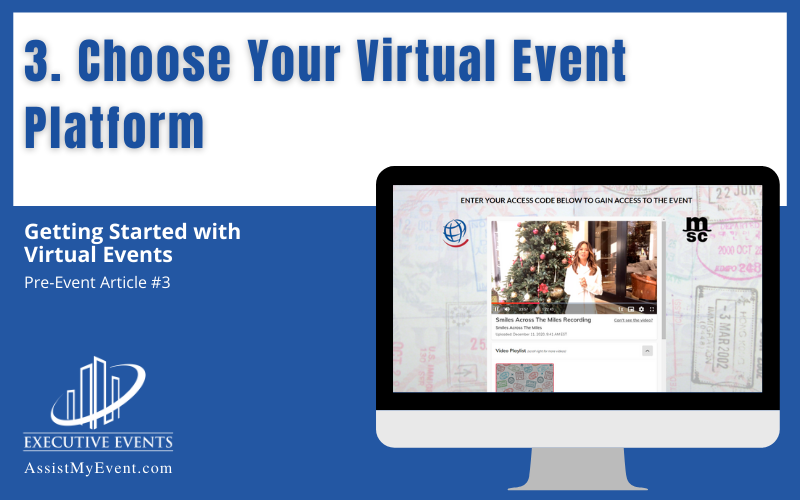Choose Your Virtual Event Platform
Getting Started with Virtual Events: Pre-Event Success Series #3
Introduction
It might seem logical to choose your virtual event platform before you determine your audience and plan your program. However, unless you know what the audience wants to gain from the event and what engagement elements you plan to offer, you won’t know what capabilities you need from your virtual platform (Tweet This!). There are many to choose from and the selection process can be a bit daunting. Knowing in advance what you need from your virtual platform will greatly ease the discomfort of combing through a pile of seemingly viable options. We will discuss what to consider, review the types of event formats and go over the kinds of platforms available.
Consider This When You Choose Your Virtual Event Platform

Audience Needs
When planning a virtual event, determining your audience and being able to meet their needs is paramount. One aspect of meeting these needs is making sure that your virtual event platform can do what you need it to do (Tweet This!). Therefore, you will need to consider virtual platform options that include breakout session capabilities and the ability to show multiple speakers simultaneously.
When working on increasing event engagement, keep in mind that it can go beyond breakout sessions to include things like sponsor and exhibitor rooms to more complicated gamification activities (Tweet This!). With gamification, your audience can receive rewards for certain actions, like visiting a sponsor’s room or by playing an actual game. Take elements such as these into consideration when selecting your top platforms.
Technology Level
When you choose your virtual event platform, also consider the technology level of your audience. Are they tech savvy? If so, then using a virtual platform with customizable avatars and life-like conference rooms should be easy for them to use. If, however, your audience is not used to computers, this kind of platform could be too difficult ot understand.
Attention Span

Whichever virtual platform you select, remember that if you don’t keep your audience’s attention, they won’t continue watching. The sessions cannot be as long as they were at an in-person event. We expect information to keep our attention and if it doesn’t, we move on to the next thing. Many people attend a virtual event from home and therefore, distractions are more prevalent. Keep your attendees’ attention by offering shorter sessions, mixing things up, throwing in a surprise or two, and offering breaks and engagement opportunities such as polls and Q&A.
What Type of Event Formats are There?
There are various ways to present a virtual event. The way you choose will ultimately depend on what goal you are trying to achieve and the needs of your audience. Generally speaking for Business-to-Business events, there are Meetings/Networking, Webinars, and Conferences/Trade Shows.
Meetings
Meetings generally consist of internal company team meetings/trainings, external prospect/client meetings and networking events. These are usually face-to-face (virtually) and attendees have the ability to participate by voice and/or chat. Videos, PowerPoints and other materials can be presented by screenshare.
Webinars
Webinars can be similar to meetings but generally the attendees won’t be participating. They will only have the capability to view the presentation. There are one or more presenters and a video or presentation will be shown. Q&A can be accomplished through a Q&A function or Chat.
Conferences/Trade Shows
Conferences/Trade Shows are more than just a presentation of talking heads and generally more robust than meetings or webinars. They could consist of informative presentations, breakout sessions, engagement activities, networking, etc. Sponsor and featured company areas can be spotlighted. Usually this spans a day or multiple days.
What Kind of Platforms are Available?
Live Streaming/Webinar Platform
A live streaming platform allows you to upload live video feeds and stream it to your audience. Sometimes you can stream directly through this platform and sometimes you need a 3rd party solution, like YouTube or StreamYard. Depending on the platform, you can supplement the live video feed with captions, lower-thirds, call-outs, etc. The live stream is very much like watching a TV show as there is usually no place to download further content. You also cannot see or hear the audience. The presenter can, however, switch between live and pre-recorded portions on some platforms.
Sponsor participation can include their logos presented throughout the live feed. Registration is handled by another platform entirely. Most live stream platforms have a chat feature and some even have a breakout feature.
Conference/Full Event Management Platform
A conference platform is usually a website which houses all of the event information and is where you can host multiple sessions. You can upload conference materials, display sponsor logos and have separate “rooms.” Engagement opportunities can include scheduling and participating in a one-on-one video chat, viewing conference slides, PDFs, images and videos, participating in gamification activities and networking.
Usually, you have the ability to access the platform before and after the event to participate in pre, during and post event activities. There is normally a robust registration module available and attendee metrics can be accessed from the platform. A big difference between a full event platform and a live streaming platform is the ability to offer several sessions at once and utilize a variety of interactive features such as: Virtual Lobbies, Sponsor Booths, Networking Rooms, Gamification, Q&A, Surveys, Polls, etc.
Choosing Your Virtual Event Platform Does Not Have to Be a Daunting Task
First, determine your goals and the needs of your audience. Then, decide what bells and whistles are needed to help enhance the event. Finally, consider your budget and the look and feel of your event. The right platform will be customizable to your needs. It will be easy for your core audience to use, will include technical support and a great team to work with for the success of your event. Most importantly, remember your event goal. Choose a platform that will enhance your event and assist you with the elements you need to achieve your virtual event goals.
the look and feel of your event. The right platform will be customizable to your needs. It will be easy for your core audience to use, will include technical support and a great team to work with for the success of your event. Most importantly, remember your event goal. Choose a platform that will enhance your event and assist you with the elements you need to achieve your virtual event goals.

